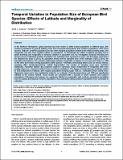Por favor, use este identificador para citar o enlazar a este item:
http://hdl.handle.net/10261/123079COMPARTIR / EXPORTAR:
 SHARE SHARE
 CORE
BASE CORE
BASE
|
|
| Visualizar otros formatos: MARC | Dublin Core | RDF | ORE | MODS | METS | DIDL | DATACITE | |

| Campo DC | Valor | Lengua/Idioma |
|---|---|---|
| dc.contributor.author | Cuervo, José Javier | - |
| dc.contributor.author | Møller, Anders Pape | - |
| dc.date.issued | 2013-10-17 | - |
| dc.identifier | doi: 10.1371/journal.pone.0077654 | - |
| dc.identifier | issn: 1932-6203 | - |
| dc.identifier.citation | PLoS ONE 8(10): e77654 (2013) | - |
| dc.identifier.uri | http://hdl.handle.net/10261/123079 | - |
| dc.description.abstract | In the Northern Hemisphere, global warming has been shown to affect animal populations in different ways, with southern populations in general suffering more from increased temperatures than northern populations of the same species. However, southern populations are also often marginal populations relative to the entire breeding range, and marginality may also have negative effects on populations. To disentangle the effects of latitude (possibly due to global warming) and marginality on temporal variation in population size, we investigated European breeding bird species across a latitudinal gradient. Population size estimates were regressed on years, and from these regressions we obtained the slope (a proxy for population trend) and the standard error of the estimate (SEE) (a proxy for population fluctuations). The possible relationships between marginality or latitude on one hand and slopes or SEE on the other were tested among populations within species. Potentially confounding factors such as census method, sampling effort, density-dependence, habitat fragmentation and number of sampling years were controlled statistically. Population latitude was positively related to regression slopes independent of marginality, with more positive slopes (i.e., trends) in northern than in southern populations. The degree of marginality was positively related to SEE independent of latitude, with marginal populations showing larger SEE (i.e., fluctuations) than central ones. Regression slopes were also significantly related to our estimate of density-dependence and SEE was significantly affected by the census method. These results are consistent with a scenario in which southern and northern populations of European bird species are negatively affected by marginality, with southern populations benefitting less from global warming than northern populations, thus potentially making southern populations more vulnerable to extinction. © 2013 Cuervo, Møller. | - |
| dc.description.sponsorship | This studied was supported by the Spanish National Research Council (grant EST001196) and by the Spanish Ministry of Science and Innovation and the European Regional Development Fund (grant CGL2008-00137/BOS). | - |
| dc.publisher | Public Library of Science | - |
| dc.relation.isversionof | Publisher's version | - |
| dc.rights | openAccess | - |
| dc.title | Temporal Variation in Population Size of European Bird Species: Effects of Latitude and Marginality of Distribution | - |
| dc.type | artículo | - |
| dc.identifier.doi | 10.1371/journal.pone.0077654 | - |
| dc.date.updated | 2015-10-07T06:34:24Z | - |
| dc.description.version | Peer Reviewed | - |
| dc.language.rfc3066 | eng | - |
| dc.rights.license | http://creativecommons.org/licenses/by-nc-sa/4.0/ | - |
| dc.contributor.funder | Consejo Superior de Investigaciones Científicas (España) | - |
| dc.contributor.funder | Ministerio de Ciencia e Innovación (España) | - |
| dc.relation.csic | Sí | - |
| dc.identifier.funder | http://dx.doi.org/10.13039/501100003339 | es_ES |
| dc.identifier.funder | http://dx.doi.org/10.13039/501100004837 | es_ES |
| dc.identifier.pmid | 24147048 | - |
| dc.type.coar | http://purl.org/coar/resource_type/c_6501 | es_ES |
| item.cerifentitytype | Publications | - |
| item.openairecristype | http://purl.org/coar/resource_type/c_18cf | - |
| item.grantfulltext | open | - |
| item.openairetype | artículo | - |
| item.fulltext | With Fulltext | - |
| Aparece en las colecciones: | (MNCN) Artículos | |
Ficheros en este ítem:
| Fichero | Descripción | Tamaño | Formato | |
|---|---|---|---|---|
| PLoS ONE 8(10) e77654 (2013).pdf | 347,36 kB | Adobe PDF |  Visualizar/Abrir |
CORE Recommender
PubMed Central
Citations
4
checked on 21-abr-2024
SCOPUSTM
Citations
26
checked on 24-abr-2024
WEB OF SCIENCETM
Citations
19
checked on 24-feb-2024
Page view(s)
193
checked on 26-abr-2024
Download(s)
182
checked on 26-abr-2024

